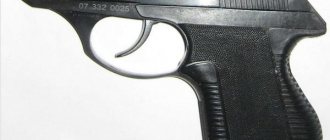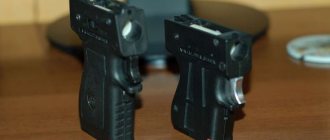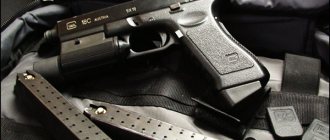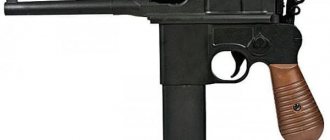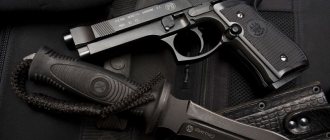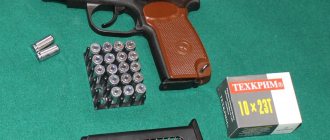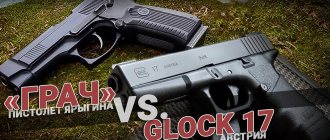Development history
The Colt 1911 traumatic pistol is an analogue of the Colt M1911 combat weapon, created by the American developer John Browning at the beginning of the last century. Externally, the copy is difficult to distinguish from the original - the same brutal (male) shape, unique design, metal body, pistol grip with pads. True, the traumatic pistol does not fire 45 ACP live ammunition, but rubber bullet shells.
Based on the American (firearm) weapon Colt M1911, many companies around the world have created sports IPCS and pneumatic copies. On the domestic market, the most famous clone of the legendary firearm is the Chinese (traumatic) model Norinco NP29. In Russia, the Colt 1911 traumatum has been manufactured by Izhevsk since 2022.
The Russian copy is of the LLC type; a special license is required to purchase this weapon. All traumatic pistols of the Colt 1911 version are marked TK1911T. Such injuries are shot with 44TK caliber cartridges (with a rubber bullet).
Background of the issue
Pistols and revolvers were widely used in the US Army at the end of the 20th century. But the country's first colonial wars, and most notably the conflict in the Philippines, showed that the military needed short-barreled, high-power weapons. It was supposed to have a relatively large sighting range, high reliability and great destructive power (reliably stop the enemy, depriving him of the ability to resist).
The Colt 1911 pistol became such a weapon, and successfully proved itself in two world wars and many local conflicts. The US Army officially removed it from service in 1985, but is still in production, and many security forces use it on their own initiative.
Description of the Colt 1911 pistol
The Colt 1911 traumatic model is similar in appearance to the Colt M1911 military weapon. True, the shutter and frame of the injury rifle are made not of steel, but of an alloy. Only the barrel remained steel (forged). The traumatic copy has a weaker design; it will not be possible to fire live ammunition from it (the weapon will explode in your hands).
The Colt 1911 pistol has a movable metal bolt casing with corrugation (notches on the front and back). On the right side of the casing there is a small “window” for extracting the cartridge case. Inside there is a steel barrel, a return spring, and a guide rod. Under the bolt there is a frame that is connected to the pistol grip. A single-row magazine for 7-9 rounds of 44TK caliber is inserted into the handle. Pistol grip grips are made of wood, plastic or rubber. On some models, the trigger and hammer have a “lightweight” (skeletal) design.
Before the first shot, it is necessary to cock (pull the bolt back). The bolt casing moves back and forth during firing. Automation of the traumatizer works on the principle of a free shutter. USM - single action trigger type. When all the cartridges in the magazine are used up, the bolt moves back and engages the bolt stop.
The pistol has open sights (adjustable rear sight and front sight). On the left side of the frame there is a fuse with a large flag. On the back of the handle there is a safety key (“shank”). You can install a collimator or optical sight on the injury.
Charge the gun before use. During shooting, the weapon is held in an outstretched (right) hand.
Before you pull the trigger, you need to remove the safety catch and take aim (align the target, the rear sight slot and the front sight on the same line). It is prohibited to point the gun unnecessarily at a person. If the limit of self-defense is exceeded, criminal liability is possible.
"Colt" from Tekhkrim
Traumatic pistol TK1911T
The market for “traumatic” weapons or OOOP is constantly updated with new models. At the end of July this year, I had a rare opportunity to be the first among Russian bloggers writing on weapons topics to talk about a new product from the company - the “traumatic” (OOOP) TK1911T pistol chambered for the .44TK cartridge. This weapon-cartridge complex is interesting not only for its technical characteristics, but also has a clear aesthetic and emotional effect.
The first “traumatic” pistol from Tekhkrim was the P226T TK-Pro, which appeared a couple of years ago. It immediately became very popular both because of the appearance of the brutal SIG-Sauer P226 and because of the powerful 10x28T cartridge.
This year, Tekhkrim mastered the production of a new pistol - a clone of the famous Colt M1911 or Government model. It’s impossible to pass by such a charismatic pistol! Personally, the M1911 has always evoked special aesthetic feelings for me. In general, it would be more correct to say that several pistols were created on the basis of the M1911 - there is also the “watered down” TK1911СХ (cartridge 10x31 mm) and the sports NP29 for 9x19 mm. But I will not consider them in detail here now; nevertheless, the most popular, in my understanding, will be the OOOP version.
However, let's move from feelings to technology. The TK1911T is based on the Chinese Norinco NP29 pistol. However, in the Tehkrim version, all that was left of him were “horns and legs.” This is due to the peculiarities of domestic weapons legislation, which prescribes the production of the main parts of the LLC in Russia. The barrel, bolt, and frame are made by Tekhkrim. But all the little things like springs, rods, magazine, etc. from Norinco NP29. It turned out that approximately 70% of the “live weight” of the pistol was Russian-made. It is interesting that the TK1911СХ, on the contrary, retained as much as possible the main parts from the NP29.
The TK1911T frame and shutter are made using high-precision lost-wax casting from an alloy.
They also showed me the injection molding models themselves.
The barrel of the pistol, of course, is forged and non-removable. There are no partitions inside the trunk, but there is a non-circular narrowing area.
Automation, unlike the prototype, operates on the free shutter principle.
I got my hands on a pre-production sample, which has seen a lot during factory testing. Of course, it is better to judge the quality of finishing of serial samples after the release of the first batch. For serial samples, several types of ceramic coating are provided.
My first impression of this pistol after holding it in my hands is that it is thinner, at least in the grip, than the original M1911. Manufacturers consider this heavy (weight 1125 g) and large-sized (218x140x36 mm) pistol to be carried in a holster. Although, I would say that a large man can easily wear it secretly.
The pistol's magazine is single-row and holds 9 rounds of .44TK caliber. Taking into account the fact that we now have a limit on the capacity of the OOOP magazine of 10 rounds, the pistol does not need a double-row magazine. The magazine is secured with a one-way button located at the base of the trigger guard.
The rear sight of the pistol is adjustable and has one bright dot on the right rear side.
The bolt has a large notch in the grip areas, both back and front. I was told that the notch pattern on production samples will be slightly different, but the application locations will remain the same.
The fuse is double-sided, with large flags that have a notch. There is a traditional M1911 safety that turns off when the grip is grasped.
When the cartridges are used up, the bolt remains in the rear position on the bolt stop and is lowered by a large lever located on the left above the cheek of the handle.
The pistol will come with a very decent waterproof case.
Cartridge .44 TK
A new cartridge has also been proposed for the TK1911T pistol, which is called .44TK. I have long been of the opinion that for a stopping effect (if we apply such a term to “traumatic” weapons) we need the largest possible caliber. The penetration effect is reduced, which is a plus for trauma, but the affected area increases.
We see a trend toward increasing caliber through the development of the most popular cartridges: 9 mm RA, then 10x28T, and now .44TK has appeared.
The new cartridge is based on a 7.62x39 mm sleeve, 30.25 mm high, with a maximum sleeve diameter of 11.35 mm. The bullet is a rubber ball with a filler with a diameter of 11.5 mm, weight 1 or 1.3 g.
As for energy, all OOOP cartridges now have it at a level not exceeding 90 J. If we compare the .44TK with other pistol “traumatic” ammunition, it looks larger than most of them. The photo shows the most common OOOP cartridges, with a .44TK to the left of each for comparison.
The recommended retail price for the fall of 2022 is predicted to be around 10 rubles per cartridge.
I think that the cartridge will take root on the market.
Field tests
Let me remind you that I tested a pre-production sample and those pistols that go into stores may differ in accuracy from mine. Still, this particular TK1911T is made partly using bypass technology.
I was interested in two shooting parameters - accuracy at medium distance (7 m) and the operation of the automatic pistol itself. I’ll say right away that I’m not a great IPCS athlete; in general, a pistol is not the most important weapon for me. I am an average pistol shooter, as they say, without any complaints.
I shot from a standing position, with both hands. The “pile” at 7 m turned out to be quite decent - apart from the gap at 5 o’clock, all the bullets ended up in a circle with a diameter of approximately 7 cm. The pistol was brought into battle for a different shooter, he has a slightly different shooting style and weapon tab, so my the pile went down to the left. But I was interested, as I already said, in accuracy.
The operation of the automation at an average rate of fire also did not present any problems.
Interestingly, after shooting at the Kevlar bullet catcher, the bullets did not crack or fall apart.
conclusions
It is very difficult to talk about a “charismatic” pistol, the purchase of which is largely emotional.
However, let's look at the pros and cons.
The advantages include: impressive appearance and moderate size; new powerful cartridge; thoughtful design.
Cons: the maximum magazine capacity is 9 rounds, which is 1 round less than the maximum allowed. As for the retail price, the first batches will be sold for about 55 thousand rubles. It is more expensive compared to competitors. But as production increases, the price may decrease.
Would I buy such a weapon for myself? Undoubtedly yes. And the reasons would lie not in the rational, but in the irrational - I want a Colt! Price, in such cases, does not matter. Well, the cartridge for this weapon is also very interesting.
In my opinion, “Tehkrim” hit the target audience with this pistol, so to speak. Yes, this is not a pistol for everyone. But whoever likes it will definitely buy it.
The first production samples of OOOP will appear in stores in September-October, and the CX version will appear earlier, in August-September.
Specifications
The main features of the Colt 1911 injury:
- trauma model;
- OOOP;
- “Legend”, “Sport” - modifications;
- body color - steel, golden, green, black;
- 80-91 J — muzzle energy;
- 390 m/s - bullet departure speed;
- preliminary platoon;
- single shooting;
- automatic recharge;
- 12.8 cm - trunk length;
- in the barrel there is one partition to prevent a shot from a live cartridge;
- 6.71 mm - outlet channel;
- 1.044-1.125 kg - weight;
- 218 x 140 x 36 (225 x 147 x 40) mm - dimensions;
- chambered for 44TK cartridges (“TEKHKRIM”);
- bullet - rubber ball 11.5 mm / 1-1.3 g;
- magazine - for 7-9 shells;
- 5-10 m - high accuracy of hitting the target;
- 20-40 mm - penetration power of ballistic gel (a substitute for human soft tissue);
- $1,000 (average price).
Characteristics of the cooled pistol Techkrim Norinco TK1911-СХ (Colt, 10×31)
| Type | Chilled pistol |
| Manufacturer | Techkream |
| Combat prototype | Sporting pistol Norinco NP29 caliber 9×19, Colt M1911 (USA) |
| Caliber | 10 x 31 mm |
| Ammunition | Light and sound cartridges 10×31 |
| Number of charges | 8 pcs |
| Possibility of disassembly/assembly | Eat |
| Shooting mode | Semi-automatic |
| Shutter material | Metal |
| Frame material | Metal |
| Color | Black |
| Size | 218 mm x 137 mm x 33.5 mm |
| Weight | 1150 grams |
| Peculiarities | The barrel has three pins and a bushing near the muzzle |
| Country of Origin | Russia |
| Equipment | Pistol, 2 magazines, cleaning rod, passport (operation manual), case |
| Product weight | 1.15 kg |
| certificate |
Cooled pistol Techkrim Norinco TK1911-СХ (Colt, 10×31) buy in the Popadiv10 online store. Cooled pistol Techkrim Norinco TK1911-СХ (Colt, 10×31) at a low price of 55,490 rubles. You can pay for your order by mail upon receipt in any part of the Russian Federation. Before placing an order, be sure to check the price and contents of the product by phone (during business hours) or by e-mail and feedback system (at any time convenient for you).
Information on the product “Cooled pistol Techkreem Norinco TK1911-СХ (Colt, 10×31)” is for informational purposes only and is not a public offer determined by the provisions of Article 437 of the Civil Code of the Russian Federation; characteristics, appearance, color and equipment can be changed by the manufacturer without notice.
Advantages and disadvantages
Pros of the Colt 1911 traumatic pistol:
- exclusive design;
- collector's model;
- looks like a combat Colt M1911;
- shoots loudly, can scare the attacker;
- easy to use;
- reliable in operation;
- does not cause serious harm to a person (unless you aim at the eye or temple).
Minuses:
- weak shot power compared to its combat counterpart;
- magazine holds only 7-9 rounds;
- tangible impact;
- high cost (from $1,000);
- Sold only under license (to legal entities).
Army record holder
The history of weapons no longer knows such a long and widespread use of a pistol. It began its career with the US Army in 1911, and is still used today, but not on a general basis, but by individual units or military personnel of their own choosing.
During the First World War, organized supplies were also made for the British Army.
The Russian Empire did not officially use Colts, but many officers purchased them themselves. Later they began to supply soldiers of the White Guard units. At the same time, the Red Army soldiers became acquainted with overseas “things” - they took them as trophies.
During World War II, deliveries to the Allies were wider - in addition to Great Britain, Free French soldiers received pistols, and even almost 13 thousand of them were delivered to the USSR under Lend-Lease. The other side also used them - Germany and Japan valued captured weapons for their power and quality. More often the samples were given to officers.
Germany also received pistols from the Norwegians, who had them in service since 1913 (after the country's military defeat).
Also, at different times, Colt in different modifications was (and is) used in Nicaragua, South Korea, Estonia, and Haiti. It was used during the Vietnam War, supplying South Vietnam.
Although experts today consider the weapon obsolete, many military personnel do not agree with them. They note the Colt's comfort in the hand, power, and reliability. Therefore, it is still in official service in a number of armies around the world.
Equipment
Factory set of Colt 1911 traumatic pistol:
- plastic waterproof case;
- gun;
- 2 stores;
- ramrod;
- brush;
- passport.
Important! 44TK caliber cartridges are not included in the kit, but must be purchased separately. A set of shells for the Colt 1911 traumatic model costs about 5-7 dollars. Additionally, you can buy safety glasses and noise-cancelling headphones for shooting.
Dismantling the injury
How to disassemble a traumatic Colt 1911:
- remove the magazine;
- move the trunk away from you;
- through the window on the bolt, check for the presence of a 44 TK cartridge in the chamber;
- pull back the shutter casing;
- remove the bolt stop;
- move the shutter forward and remove it from the frame;
- the barrel, spring and guide rod will be removed along with the bolt;
- remove the guide sleeve (near the barrel);
- pull out the spring with the guide rod and the barrel itself from the bolt casing;
- the frame will remain attached to the pistol grip.
The injury is assembled in the reverse order of disassembly. The Colt 1911 pistol is disassembled exclusively before cleaning. It is advisable to clean your weapon after each shooting. For cleaning, it is recommended to use special cleaning agents and products.
Improving the model
Although the use of the Colt 1911 in Europe during the First World War showed its practicality, some design flaws also made themselves felt.
- The gun was very heavy.
- It had significant recoil, which reduced accuracy and generally made shooting difficult.
- The number of cartridges in the magazine turned out to be insufficient.
- The mechanism was sensitive to contamination, it had to be constantly cleaned, and this required extensive spare parts and accessories.
It must be said that this opinion about the shortcomings of the Colt 45 caliber was not unanimous. Many believed that it was even more comfortable than its counterparts for shooters with smaller hands and strength. The recoil also did not seem excessive to everyone; some officers claimed that it was smooth and did not throw up the barrel.
But still, in 1926, the design of the pistol underwent some changes. They were designed to eliminate some of the listed shortcomings.
- The accuracy of firing has increased.
- The descent stroke and the force required for it have decreased. This made it possible to increase the rate of fire.
- The “tail” of the fuse has become longer - before it was not easy for everyone to reach it.
- The shape of the handle has changed.
The new pistol was named Colt M1911A1. He continued to serve in all security and law enforcement agencies of the United States and a number of other countries to this day.



